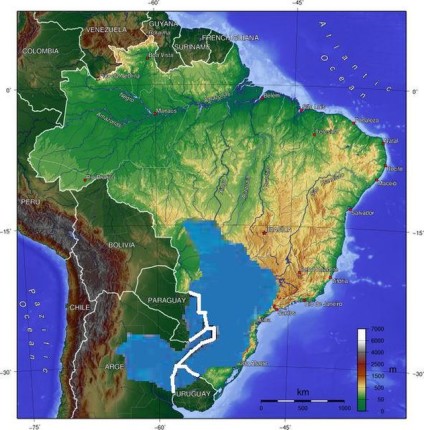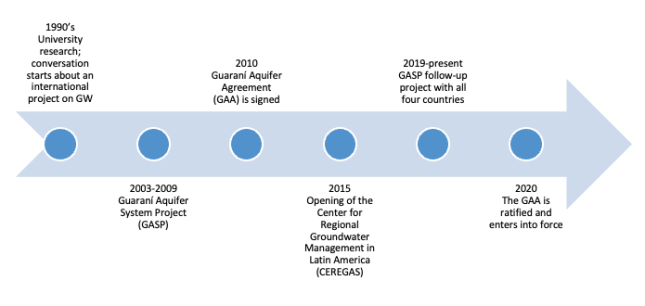-
Water Cooperation and Scientific Networks: A Work of Passion
October 17, 2023 By Tova Crystal
Groundwater is relied upon for roughly half of global drinking water. And as climate change alters precipitation patterns and pollution of surface water continues to increase, our collective dependence on groundwater is likely to increase.
Getting ahead of the potential conflicts, or in some cases, catching up with them, requires an increase in effective groundwater cooperation and diplomacy. Yet the vast majority of transboundary aquifers exist without any form of agreement among the states that share them. This state of affairs leaves the aquifers—and the people who rely upon them—vulnerable to overexploitation, environmental degradation, and the risk of interstate conflict.
South America’s Guaraní Aquifer—where a close-knit network of groundwater professionals got ahead of the problem—is a case study for possible solutions. These dedicated individuals worked together to achieve successful groundwater cooperation and scientific advancement. Research conducted in Uruguay in 2023 with the actors of the network found that the relationships forged through this work hold important insights for transboundary groundwater cooperation.
The Story Begins
The Guaraní Aquifer is shared by Uruguay, Brazil, Argentina, and Paraguay. It is also one of only transboundary aquifers in the world with an agreement in place between nations. The Guaraní Aquifer Agreement (GAA) has been applauded as preventative diplomacy, since no major conflict over the aquifer existed at the time of its creation—nor does conflict lurk now.
Yet the GAA can also be seen as the political culmination of decades of effort from the region’s groundwater scientific community. In the 1990s, the governments of Uruguay and Brazil were interested in securing funding from the Global Environmental Facility (GEF) for a project on transboundary water. Around the same time, a group of universities in the region met with the World Bank to discuss the unfurling knowledge about the Guaraní aquifer.
The GEF informed Uruguay and Brazil that an international groundwater project would be possible if all four countries of the Guaraní were involved—and they soon were. This project was known as the GASP (Guaraní Aquifer System Project) and is a source of great pride among many involved in its progress. This small group of academics from the 1990s formed the foundation of the present-day network of groundwater scientists. Their desire to discover more about the groundwater beneath them sparked international water cooperation over the next 30 years.
Scientific cooperation has been—and continues to be—critical to the transboundary water governance of the Guaraní Aquifer. Since the end of the GASP in 2009, the scientific network has gone on to open the Center for Regional Groundwater Management, which then led to the procurement of a second GEF-funded project on the Guaraní that is currently underway. The network is also working hard to ensure that the countries follow through on the content of the GAA, specifically in creating an international commission for conflict resolution. The events in the timeline above (Figure 1) are tied together directly by the people involved. The close-knit dynamics of this scientific network held the key to its success in influencing transboundary water cooperation. This model—and the relationships that made it work—also holds clues about ways to harness scientific networks to promote wider cooperation.
A Close-Knit Community
The groundwater professionals working in the Guaraní region maintain friendly and comfortable relationships. Many of them have been advocating together for improved groundwater governance for more than two decades. Participants in this project often describe a “nucleus” of people working with the aquifer, projecting the image of a small, core group working in sync with one another. This nucleus obtained external recognition as well, since its core members often participated regularly in congressional events and teaching courses. Those involved also credit the easy flow of data and robust collaboration to the small nature of the network.
Commitment to the cause at hand has been a critical element for the longevity and strength of the network. But the long-term commitment to the Guaraní Aquifer effort is not just a happy accident. Concrete elements have fostered this commitment. From early on in their careers, groundwater was of great interest to the study participants. As one of them put it: “I dedicated myself to groundwater…[it] is my pleasure.” Many of them also expressed a deep emotional connection to their work. Some of them also described a moral/ethical belief in sharing and protecting the groundwater at the center of the work.
Connections are reinforced and strengthened in this atmosphere of shared belief and passion. Working with others who relate to the work and each other in this way creates an environment that validates an individual’s experience, gives value to their perspective, and ultimately encourages them to keep going. This positive feedback loop is critical for sustained action within the network. It promotes commitment and strong relationships among those who see their passion reflected in their colleagues.
Getting Political
Many of the participants observed that there was a difference between collaborating with their fellow scientists and working with government officials. One key distinction gleaned from interviews with scientists in the network is the way they understand groundwater and their view of how it should be governed. The majority of the scientific community believes in shared management of groundwater—a belief informed by the moral responsibility they feel to protect this resource. In contrast, governments tend to view groundwater as a strategic resource over which they must maintain autonomy.
This difference in strategy is essentially a difference in values and beliefs. And it can help explain an important shortcoming of the scientific network’s efforts: a lack of connection to the government.
Many of the study participants have grown frustrated that the data they generate—from the GASP and beyond—often sits in the storage rooms of universities and online depositories, where it does not create the impact envisioned by the scientists. This scientific network has made huge strides in regional groundwater management, yet these achievements do not pack the punch that many scientists want to deliver.
The lack of a network between the scientific community and the government may be one reason for this. Communication and collaboration between the two groups are limited, as well as feelings of being understood and valued.
There has also been little to no encouragement for the scientific network to create connections with the government. By contrast, GASP activities were carried out to intentionally include both government and scientific actors. During this time, study participants also remember feeling involved at every governance level.
Now, there is no evidence of meaningful collaboration. Strong scientific cooperation goes farther when there are channels with other parts of society through which to funnel information, ideas, and passion.
Beyond One Network
Groundwater scientists in the Guaraní Aquifer region have harnessed their passion, beliefs, and relationships to create a flourishing network that influences international groundwater cooperation. Yet the factors that bring them together also hinder the creation of important connections outside of their own community. The case of the Guaraní can be read both as a message of inspiration for scientific networks that want to influence change—and as a warning not to get caught in a collective echo-chamber.
The future challenge for scientific networks is not only to foster close-knit working dynamics that fuel motivation and commitment, but also to expand those meaningful connections to include other disciplines and other sectors of society. Creating a shared experience of feeling understood and valued by nurturing people’s passions and making connections between one another’s core beliefs may be key to a meaningful expansion of the network—as well as its ability to yield greater influence on international water cooperation.
The research on which this blog post is based was supported by IHE Delft Institute for Water Education under the Netherlands Ministry of Foreign Affairs DUPC 2 Water Diplomacy Project and with the support of Susanne Schmeier and Jenniver Sehring of the MSc supervisory team.
Tova Crystal holds an MSc in Water Management and Governance from IHE Delft Institute for Water Education in the Netherlands. She is now a researcher at IHE under the Knowledge and Innovations study group, the program manager of the Youth for the Rhine network, and an editor for OneWater.
Sources: Environmental Science & Policy; Jornadas de Jóvenes Investigadores; Journal of Hydrology: Regional Studies; UN; UNESCO
Photo credit: Location of the Guaraní Aquifer on the map of South America, courtesy of Nathan Sodré Salvatierra/Wikimedia Commons.
 A Publication of the Stimson Center.
A Publication of the Stimson Center.




